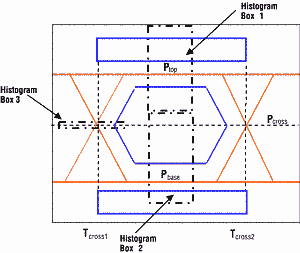
Contact us
Live Chat with Tek representatives. Available 6:00 AM - 4:30 PM
Call
Call us at
Available 6:00 AM – 5:00 PM (PST) Business Days
Download
Download Manuals, Datasheets, Software and more:
Feedback
Communications Eye-diagram Measurements Software
TDSCEM1
The products on this datasheet are no longer being sold by Tektronix.
View Tektronix Encore for reconditioned test equipment.
Check support and warranty status for these products.

TDSCEM1
Features & Benefits
- Perform Automatic Eye Diagram Measurements of: % Crossing, Eye Height, Eye Width, Quality Factor, Extinction Ratio and Jitter
- Provides More In-depth Understanding of Your Communication Signal Beyond Qualitative Pass/Fail Mask Testing
- Adds Additional Capability to Your TDS Communications Analyzer Package by Enabling Your TDS500/700 Series Oscilloscope to Perform Automated Eye Diagram Measurements
- Optical Standards Measured Include:
- SONET/SDH: OC1/STM0, OC3/STM1, OC12/STM4
- Fibre Channel: FC133, FC266, FC531, FC1063
- Gigabit Ethernet: 1.25 Gb/s
- With the Unique Autoset to Standard Mask Capability, You Do Not Need to Set Up the Vertical, Horizontal, Trigger or Filter Controls
- Set the Population Size for the Statistics Measurements
- Log the Measurement Results to a File for Future Analysis
- GPIB Control of Measurements for Use in ATE Applications
- Installs Inside the TDS Oscilloscope Requiring no External GPIB, RS-232 or PC
Applications
- Characterize the Quality of Your Optical Communications Signals with Accurate Eye Diagram Analysis
User-installed, Oscilloscope Resident Eye Diagram Measurement Package
Option 2C, the Tektronix TDS Communication Signal Analyzer package, gives you the most comprehensive oscilloscope solutions for connecting to, capturing and characterizing optical and electrical signals in high-speed communication designs. Based on the TDS500D/700D family of Digital Phosphor Oscilloscopes (DPOs), Option 2C and various measurement accessories tailor the oscilloscope for engineers debugging, characterizing and verifying the compliance of communication systems to international standards.
TDSCEM1 adds additional capability to Option 2C by allowing communication customers to perform quantitative measurements on their eye diagrams in addition to qualitative mask testing. TDSCEM1 provides an extensive suite of additional measurements to support analysis and trouble-shooting beyond simple pass-fail testing.
The following diagram and text describe the measurements performed:

T cross1= time at which the first crossing occurs.
T cross2= time at which the second crossing occurs.
P top = mean of the most predominant peak in the histogram for box 1.
P base = mean of the most predominant peak in the histogram for box 2.
P cross = level at which the first crossing occurs.
- Crossing % is the location of the zero crossing as a % of the eye opening
- Crossing % = 100 [(Pcross - Pbase)/(Ptop - Pbase)]
- Eye Height is the vertical opening of the eye
- Eye height = (Ptop - 3(sigma)top) - (Pbase + 3(sigma)base)
- Eye Width is the horizontal opening of the eye
- Eye width = (Tcross2 - 3(sigma)cross2) - (Tcross1 + 3(sigma)cross1)
- Quality Factor is the vertical opening of the eye relative to the noise present
- Quality factor = (Ptop - Pbase)/((sigma)top + (sigma)base)
- Extinction Ratio is the ratio of the average high logic level to the average low logic level. In the Option 2C extinction ratio measurement, the Ptop and Pbase levels are determined by using all high logic levels and all low logic low levels. In the TDSCEM1 application, the Ptop and Pbase levels are determined by using the middle 20% of the eye opening. In addition, the TDSCEM1 extinction ratio measurement allows the user to determine the statistical population size before the measurement is performed.
- Ext ratio = Ptop/Pbase
- Ext Ratio % = 100[(Pbase - Pdark)/(Ptop - Pdark)]
- Ext Ratio dB = 10 Log [(Ptop - Pdark)/(Pbase - Pdark)]
- Jitter is the time variation of the signal zero crossing
- Jitter RMS = (sigma)
- Jitter 6sigma = 6(sigma)
- Jitter PP = max - min
Customers who will benefit from TDSCEM1 are electronic design engineers working for communication equipment manufacturers in the communications industry who develop products with standard communication interfaces. These engineers need tools to properly characterize their designs and verify compliance to industry standards. These standards include SONET/SDH, Fibre Channel and Gigabit Ethernet. Characterization of these optical and electrical signals include mask testing as well as eye diagram measurements.
TDSCEM1 comes on a single floppy disk, is easily installed in a TDS oscilloscope and doesn't require any external processing or connections. After installation, the application is accessible from the oscilloscope front panel.
Characteristics
Tektronix Oscilloscopes Supported
TDS500D, TDS700D Series oscilloscopes with Communication Signal Analyzer Opt. 2C and a hard disk drive (Opt. HD or Opt. 2M).
Ordering Information
TDSCEM1
Communications Eye Diagram Measurement Software for TDS500/700 Oscilloscopes.
Includes: Software on a 3.5 in. Disk, Manual.
NOTE: Requires TDS500/600/700 Opt. HD or 2M, and TDS500/700 Communication Signal Analyzer Opt. 2C, FW v6.4e.
TDSCEM1 Recommended Options and Accessories
AMT75 - 75 Ω adapter.
TDS Opt. 3C - (includes P6701B) Short-wavelength fibre channel optical reference receiver.
TDS Opt. 4C - (includes P6703B) Long-wavelength SONET/SDH optical reference receiver.
P6701B/P6703B - Optical-to-electrical converters.
OA5002/OA5012/OA5022/OA5032 - Optical Attenuators.

